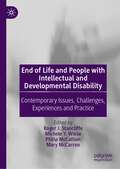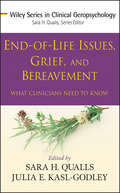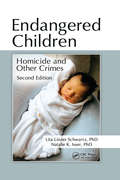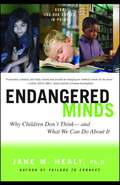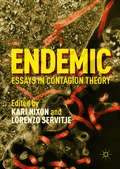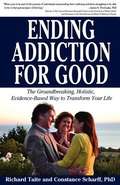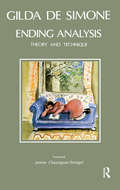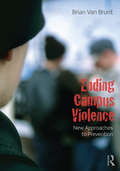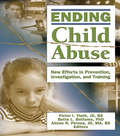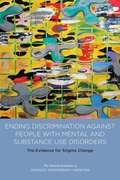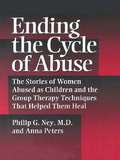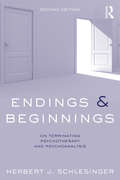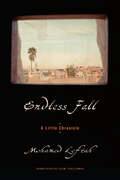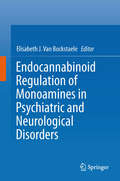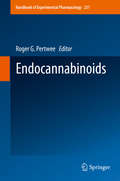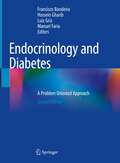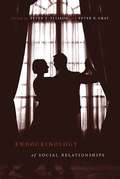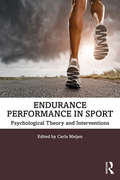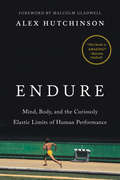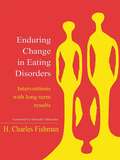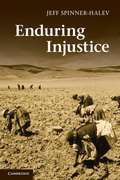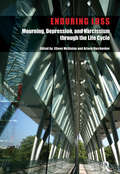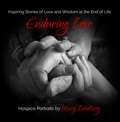- Table View
- List View
End of Life and People with Intellectual and Developmental Disability: Contemporary Issues, Challenges, Experiences and Practice
by Philip McCallion Roger J. Stancliffe Michele Y. Wiese Mary McCarronThis book on end of life examines how to include people with intellectual and developmental disability in the inevitability of dying and death. Comprising 17 chapters, it addresses challenging and under-researched topics including suicide, do-not-resuscitate, advance care planning, death doulas and accessible funerals. Topics reflect everyday community, palliative care, hospice and disability services.The book proposes that the rights of people with disabilities should be supported up to and after their death. Going beyond problem identification, the chapters offer positive, evidence-supported responses that translate research to practice, together with practice examples and resources grounded in lived experience. The book is applicable to readers from the disability field, and mainstream health professionals who assist people with disability in emergency care, palliative care or end-of-life planning
End-Stage Dementia Care: A Basic Guide
by C. R. KovachPeople with mid-stage dementia are served by special care units in long-term care facilities, although as these residents deteriorate, they are transferred out of the unit and into a general nursing home unit. These nursing homes are not equipped to deal with palliative needs of end-stage dementia care. The book addresses those needs. With this in mind, Part One examines the stages of dementia end-stage in particular. Other chapters in this section provide background on the hospice movement and hospice concepts; the idea of maintaining personhood; and administration of a late-stage care unit. Part Two focuses on treatment approaches for common needs in end-stage dementia - medical and physical care; a supportive environment; the fundamentals of care; psychopharmacology; and therapeutic activities. Part 3 contains chapters on family-centred care; legal and ethical issues; programme evaluation; and future opportunities.
End-of-Life Issues, Grief, and Bereavement
by Sara Honn Qualls Julia E. Kasl-GodleyA practical overview of clinical issues related to end-of-life care, including grief and bereavement The needs of individuals with life-limiting or terminal illness and those caring for them are well documented. However, meeting these needs can be challenging, particularly in the absence of a well-established evidence base about how best to help. In this informative guide, editors Sara Qualls and Julia Kasl-Godley have brought together a notable team of international contributors to produce a clear structure offering mental health professionals a framework for developing the competencies needed to work with end-of-life care issues, challenges, concerns, and opportunities. Part of the Wiley Series in Clinical Geropsychology, this thorough and up-to-date guide answers complex questions often asked by patients, their families and caregivers, and helping professionals as well, including: How does dying occur, and how does it vary across illnesses? What are the spiritual issues that are visible in end-of-life care? How are families engaged in end-of-life care, and what services and support can mental health clinicians provide them? How should providers address mental disorders that appear at the end of life? What are the tools and strategies involved in advanced care planning, and how do they play out during end-of-life care? Sensitively addressing the issues that arise in the clinical care of the actively dying, this timely book is filled with clinical illustrations, guidance, tips for practice, and encouragement. Written to equip mental health professionals with the information they need to guide families and others caring for the needs of individuals with life-threatening and terminal illnesses, End-of-Life Issues, Grief, and Bereavement presents a rich resource for caregivers for the psychological, sociocultural, interpersonal, and spiritual aspects of care at the end of life. Also in the Wiley Series in Clinical Geropsychology Psychotherapy for Depression in Older Adults Changes in Decision-Making Capacity in Older Adults: Assessment and Intervention Aging Families and Caregiving
Endangered Children: Homicide and Other Crimes, Second Edition
by Lita Linzer Schwartz Natalie K. IsserFrom infancy onward, children are in danger from many sources, including parental and sibling abuse, drug abuse and mental illness in the home, parental neglect, and poverty. Removing an at-risk child from a troubled environment brings on a host of new concerns and is not always a panacea. Endangered Children: Homicide, and Other Crimes, Second Edi
Endangered Minds: Why Children Dont Think And What We Can Do About I
by Jane M. HealyIs today's fast-paced media culture creating a toxic environment for our children's brains?In this landmark, bestselling assessment tracing the roots of America's escalating crisis in education, Jane M. Healy, Ph.D., examines how television, video games, and other components of popular culture compromise our children's ability to concentrate and to absorb and analyze information. Drawing on neuropsychological research and an analysis of current educational practices, Healy presents in clear, understandable language:-- How growing brains are physically shaped by experience-- Why television programs -- even supposedly educational shows like Sesame Street -- develop "habits of mind" that place children at a disadvantage in school-- Why increasing numbers of children are diagnosed with attention deficit disorder-- How parents and teachers can make a critical difference by making children good learners from the day they are born
Endemic
by Kari Nixon Lorenzo ServitjeThis book develops a new multimodal theoretical model of contagion for interdisciplinary scholars, featuring contributions from influential scholars spanning the fields of medical humanities, philosophy, political science, media studies, technoculture, literature, and bioethics. Exploring the nexus of contagion's metaphorical and material aspects, this volume contends that contagiousness in its digital, metaphorical, and biological forms is a pervasively endemic condition in our contemporary moment. The chapters explore both endemicity itself and how epidemic discourse has become endemic to processes of social construction. Designed to simultaneously prime those new to the discourse of humanistic perspectives of contagion, complicate issues of interest to seasoned scholars of science and technology studies, and add new topics for debate and inquiry in the field of bioethics, Endemic will be of wide interest for researchers and educators.
Ending Addiction for Good: The Groundbreaking, Holistic, Evidence-Based Way to Transform Your Life
by Richard Taite Constance ScharffThere is hardly a family in the post-industrial world that hasn't been affected in some way by addiction. Yet seeking treatment for a struggling loved one is, for most people, a frightening and overwhelming prospect. Ending Addiction for Good offers a powerful message of hope. Drawing on their own histories of addiction recovery, authors Taite and Scharff examine the unique and highly successful treatment protocol practiced at the Cliffside Malibu Addiction Treatment Center. Using clear and direct language, they look beyond the limits of conventional treatment to show how creating an individualized, evidence-based, and integrated approach that targets the whole person - mind, body, and spirit - not just the addiction, can provide a sure path to recovery. In doing so, they empower both the addict and the families of addicts to begin their recovery. Ending Addiction for Good may well be the most important book dealing with alcoholism and drug addiction to come along in years.
Ending Analysis: Theory and Technique
by Gilda De SimoneThis book, beyond dealing with the theoretical and technical questions concerning the termination of analysis, gives a picture of the particular nature of the psychoanalytic cure in relation to the therapies that have come forth from psychoanalytic roots. The theoretical work is supported by rich clinical details.
Ending Campus Violence: New Approaches to Prevention
by Brian Van BruntWith the growth of threats and violence in higher education settings, college campuses are increasingly expected to have systems in place to identify potentially aggressive individuals and intervene to ensure the safety of the campus population. This book will be useful for student affairs professionals as well as college counselors, psychologists, social workers interested in the practical management of aggression and violence on a college campus. It will also be a valuable resource for those involved in creating and running behavioral intervention teams and threat/risk assessment teams. Ten case studies from both the community and residential college settings provide a comprehensive overview of campus violence and how to intervene to prevent it. Pertinent background information is discussed as an introduction to these narratives, such as the fundamentals of aggression and violence on campuses; how these behaviors can impact students, faculty, and staff; and what can be learned from past campus violence. Along with discussion questions and a review of ways to approach each situation, experts in higher education, forensic risk assessment, law enforcement, and legal issues weigh in on each case study. Their perspectives offer a context and broad base of opinions and ideas on how each case could be handled. Additional examples for further training of the college counselor are given through a detailed look at almost 100 incidents of violence, including thwarted attacks, rampage shootings, and hostage situations.
Ending Child Abuse: New Efforts in Prevention, Investigation, and Training
by Victor I. Vieth Bette L. Bottoms Alison PeronaGet the tools to coordinate a plan in your community!The highly anticipated Ending Child Abuse: New Efforts in Prevention, Investigation, and Training presents an exciting vision: to end or significantly reduce child abuse. Respected social scientists and legal scholars discuss empirically sound short- and long- term multidisciplinary strategies that can be implemented in our society. Innovative and well-established concepts and approaches are clearly presented, such as specialized education, rational preventative methods, effective investigation and prosecution strategies, and the analysis of factors that influence law enforcement investigations and child abuse prevention efforts.Several obstacles stand in the way of the elimination of child abuse, such as the failure to investigate most child abuse reports, inadequate training of frontline child protection professionals, lack of financial resources, and the dilemma that child abuse is not addressed at the youngest ages. Ending Child Abuse: New Efforts in Prevention, Investigation, and Training tackles these problems and others with practical guidelines and aggressive creative strategies that can be applied to every community in the United States. This collection is impeccably referenced and soundly supported with research.Ending Child Abuse: New Efforts in Prevention, Investigation, and Training discusses: implementation of a model curriculum in child advocacy for undergraduate and graduate institutions forensic interview training extensive education of the nation&’s child protection professionals development and funding of prevention programs at the community level educational reforms of Montclair State University in New Jersey designed to better prepare professionals who advocate for children research-based interview techniques with best practice guidelines possible broader social and system-level reforms vertical prosecution of child abuse cases-with a model for its operationEnding Child Abuse: New Efforts in Prevention, Investigation, and Training is an ambitious eye-opening source perfect for social services professionals, mental health professionals, practitioners, researchers, educators, students, and medical and legal professionals who deal with child abuse and children&’s welfare.
Ending Discrimination Against People with Mental and Substance Use Disorders: The Evidence for Stigma Change
by Engineering Medicine National Academies of SciencesEstimates indicate that as many as 1 in 4 Americans will experience a mental health problem or will misuse alcohol or drugs in their lifetimes. These disorders are among the most highly stigmatized health conditions in the United States, and they remain barriers to full participation in society in areas as basic as education, housing, and employment. Improving the lives of people with mental health and substance abuse disorders has been a priority in the United States for more than 50 years. The Community Mental Health Act of 1963 is considered a major turning point in America’s efforts to improve behavioral healthcare. It ushered in an era of optimism and hope and laid the groundwork for the consumer movement and new models of recovery. The consumer movement gave voice to people with mental and substance use disorders and brought their perspectives and experience into national discussions about mental health. However over the same 50-year period, positive change in American public attitudes and beliefs about mental and substance use disorders has lagged behind these advances. Stigma is a complex social phenomenon based on a relationship between an attribute and a stereotype that assigns undesirable labels, qualities, and behaviors to a person with that attribute. Labeled individuals are then socially devalued, which leads to inequality and discrimination. This report contributes to national efforts to understand and change attitudes, beliefs and behaviors that can lead to stigma and discrimination. Changing stigma in a lasting way will require coordinated efforts, which are based on the best possible evidence, supported at the national level with multiyear funding, and planned and implemented by an effective coalition of representative stakeholders. Ending Discrimination Against People with Mental and Substance Use Disorders: The Evidence for Stigma Change explores stigma and discrimination faced by individuals with mental or substance use disorders and recommends effective strategies for reducing stigma and encouraging people to seek treatment and other supportive services. It offers a set of conclusions and recommendations about successful stigma change strategies and the research needed to inform and evaluate these efforts in the United States.
Ending The Cycle Of Abuse: The Stories Of Women Abused As Children & The Group Therapy Techniques That Helped Them Heal
by Philip G. Ney Anna PetersFirst published in 1995. Routledge is an imprint of Taylor & Francis, an informa company.
Endings and Beginnings: On terminating psychotherapy and psychoanalysis
by Herbert J. SchlesingerIn this second edition of Endings & Beginnings (Routledge, 2006), Herbert J. Schlesinger explores endings and beginnings within psychoanalysis and psychoanalytic therapy; both the obvious main endings and beginnings of any course in treatment, and the many little endings and beginnings that permeate analysis. The second edition contains new chapters including one on transference and counter-transference as sources of information about the process of therapy and as sources of difficulty in ending. It deals especially with the impact of prospective ending on the therapist, which if not understood and well handled, might interfere with working through and impede termination, if not ending itself. Another new chapter deals with the difficulties in terminating with especially narcissistic patients. One of the main criticisms against psychoanalysis and the psychotherapies derived from it is that it lacks criteria for when the patient has had enough. Herbert J. Schlesinger shows how we may view the process as a series of episodes each with an ending and possibly with a new beginning. He presents the way patients signal, even before they are aware of it, that ending is "in the air," and how it organizes how they experience the therapy. If alerted, the therapist can make use of these signals to locate self and patient in the process. So informed, the therapist is better able to discern when the therapy should end and help the patient work through the issues of separation and loss to terminate the treatment constructively. All patients tend to end psychotherapy in the way they end all other relationships. In several chapters on the problems related to severe regression, therapists can learn how to help vulnerable patients, for whom attachment is problematic, deal with separation non-traumatically. In Endings & Beginnings 2nd Edition, the theory of the continuous experience of ending and beginning and the array of landmarks that parse the clinical process are distinct advances to the technique of psychoanalysis and the psychotherapies derived from it. Schlesinger offers many clinical examples of ending and beginning with their technical problems and solutions. This contribution to the technique of ending and beginning psychotherapy electively will be useful to practicing psychotherapists and psychoanalysts, and to undergraduate and post-graduate students in clinical psychology, psychiatry and social work.
Endless Fall: A Little Chronicle
by Mohamed LeftahIn this poignant account of a classmate&’s suicide, the acclaimed Moroccan author gives both a biting critique of small-town bigotry in the 1960s and a moving tribute to the fleeting beauty of adolescence.In Settat in the 1960s, when it was still a tiny village, a young man leapt to his death in front of his stunned class and their teacher, left holding a brief, devastating suicide note. Among the students was Mohamed Leftah. Haunted by the uncommon grace of that desperate act, and the tragic image of his body lying in the courtyard, Leftah penned this chronicle of life at the time, marked by repressed desire and shame.A fiery yet thoughtful meditation on taboo acts—homosexuality, adultery, suicide—and the hypocrisy and cruelty often found in those who judge them, Endless Fall also offers a fascinating window into the mind of the seminal writer.
Endocannabinoid Regulation of Monoamines in Psychiatric and Neurological Disorders
by Elisabeth J. Van BockstaeleThe past decade has seen tremendous growth in the study of cannabinoid receptor signaling in brain. The impact and consequences of cannabinoid modulation of monoaminergic (dopamine, norepinephrine, and serotonin) circuits is becoming more clear. Scientists have shown significant interaction between these two systems in a variety of psychiatric and neurological disorders such as affective disorders, multiple sclerosis, and pain or pain disorders. The overarching goal of Endocannabinoid Regulation of Monoamines in Psychiatric and Neurological Disorders is to provide current information on advances in the field of endocannabinoid signaling and potential therapeutic applications with a particular emphasis on monoaminergic circuits.
Endocannabinoids
by Roger G. PertweeThere is currently considerable interest in the development of medicines that would enhance endocannabinoid-induced "autoprotection", for example through inhibition of endocannabinoid metabolizing enzymes or cellular uptake processes or that would oppose endocannabinoid-induced "autoimpairment". This volume describes the physiology, pathophysiology and pharmacology of the endocannabinoid system and potential strategies for targeting this system in the clinic.
Endocrinology and Diabetes: A Problem Oriented Approach
by Francisco Bandeira Hossein Gharib Luiz Griz Manuel FariaDeveloped by a renowned group of international authors, this engaging, case-based title once again offers readers a wide range of thought-provoking case studies that reflect contemporary, challenging, hands-on clinical care. Expanded and fully updated, Endocrinology and Diabetes: A Problem Oriented Approach, 2nd Edition addresses the complete range of endocrinologic problems found in patient care, offering the reader a convenient and pointed way to solve clinical problems in a timely manner. Due to its comprehensive coverage and practical focus, this title has developed a special place in the field of endocrinology and will again be of great interest to endocrinologists, diabetologists, internal medicine physicians, family physicians, fellows, and residents. The enthusiastic reception and warm welcome of the first edition of this book was overwhelming and gratifying. Despite many standard texts that cover physiology and clinical aspects of endocrinology, this book found a special place because it focused on patient care and practical aspects of endocrine practice. In the current volume we were fortunate to again have the honor of collaboration by international authors who pride themselves foremost as clinical endocrinologists. We hope our readers will find this updated, improved edition worthwhile, and use it for the benefit of their patients.
Endocrinology of Social Relationships
by Peter B. Gray Peter T. EllisonIn social relationships―whether between mates, parents and offspring, or friends―we find much of life’s meaning. But in these relationships, so critical to our well-being, might we also detect the workings, even directives, of biology? This book, a rare melding of human and animal research and theoretical and empirical science, ventures into the most interesting realms of behavioral biology to examine the intimate role of endocrinology in social relationships. <P><P>The importance of hormones to reproductive behavior―from breeding cycles to male sexual display―is well known. What this book considers is the increasing evidence that hormones are just as important to social behavior. Peter Ellison and Peter Gray include the latest findings―both practical and theoretical―on the hormonal component of both casual interactions and fundamental bonds. The contributors, senior scholars and rising scientists whose work is shaping the field, go beyond the proximate mechanics of neuroendocrine physiology to integrate behavioral endocrinology with areas such as reproductive ecology and life history theory. Ranging broadly across taxa, from birds and rodents to primates, the volume pays particular attention to human endocrinology and social relationships, a focus largely missing from most works of behavioral endocrinology.
Endurance Performance in Sport: Psychological Theory and Interventions
by Carla MeijenAthletes participating at all levels of endurance performance can relate to the impact of psychological factors. Whether it is motivation, self-belief, feeling nervous before a race, exercise-induced pain, sticking to a pacing strategy, or thoughts around what to focus on, there are a vast number of psychological factors which can affect endurance performance. Bringing together experts in the field from around the world, this is the first text to provide a detailed overview of the psychology of endurance performance where there is a research and an applied focus looking at both main theoretical models as well as how interventions can support an athlete’s efficacy and well-being. The authors look at regulatory processes around pain, decision-making, self-belief, emotions, and meta-cognition, before examining a range of cognitive strategies, including the use of imagery, goals, self-talk, and mindfulness techniques. With a final section of the book outlining issues related to mental health that are relevant to endurance performance, the book shows that the future of research and application of psychological theory in endurance performance in sport is bright and thriving. Aimed at researchers, students, coaches, and athletes themselves, this is essential reading for anyone wishing to better understand how our minds experience endurance in performance arenas, and what psychological techniques can be used to make us more efficient.
Endure: Mind, Body, and the Curiously Elastic Limits of Human Performance
by Malcolm Gladwell Alex Hutchinson"Reveals how we can all surpass our perceived physical limits." —Adam Grant • "This book is AMAZING!" —Malcolm GladwellLimits are an illusion: a revolutionary book that reveals the secrets of reaching the hidden extra potential within us allForeword by Malcolm GladwellThe capacity to endure is the key trait that underlies great performance in virtually every field—from a 100-meter sprint to a 100-mile ultramarathon, from summiting Everest to acing final exams or completing any difficult project. But what if we all can go farther, push harder, and achieve more than we think we’re capable of?Blending cutting-edge science and gripping storytelling in the spirit of Malcolm Gladwell—who contributes the book’s foreword—award-winning journalist Alex Hutchinson reveals that a wave of paradigm-altering research over the past decade suggests the seemingly physical barriers you encounter as set as much by your brain as by your body. This means the mind is the new frontier of endurance—and that the horizons of performance are much more elastic than we once thought.But, of course, it’s not “all in your head.” For each of the physical limits that Hutchinson explores—pain, muscle, oxygen, heat, thirst, fuel—he carefully disentangles the delicate interplay of mind and body by telling the riveting stories of men and women who’ve pushed their own limits in extraordinary ways.The longtime “Sweat Science” columnist for Outside and Runner’s World, Hutchinson, a former national-team long-distance runner and Cambridge-trained physicist, was one of only two reporters granted access to Nike’s top-secret training project to break the two-hour marathon barrier, an extreme quest he traces throughout the book. But the lessons he draws from shadowing elite athletes and from traveling to high-tech labs around the world are surprisingly universal. Endurance, Hutchinson writes, is “the struggle to continue against a mounting desire to stop”—and we’re always capable of pushing a little farther.
Enduring Change in Eating Disorders: Interventions with Long-Term Results
by H. Charles FishmanEnduring Change in Eating Disorders provides a unique perspective on the successful treatment of eating disorders, which are among the most debilitating and recalcitrant psychiatric diseases. Unique in the field, this book details effective Structural Family Therapy with qualitative follow-ups of up to 20 years. A practical approach providing concrete tools to the clinician to creating change that holds over time with bulimia, anorexia, and compulsive overeating. The text draws on cases from the author's practice of over twenty-five years and follows his approach in the theoretical tradition of Intensive Structural Family Therapy (IST). Chapters discuss the nature and significance of eating disorders, a review of current treatment approaches, and the importance of the family in the therapeutic process. Cases of eating disorders in youths and adults are provided as well as instances of bulimia, anorexia, and compulsive overeating. Three appendices provide the reader with information regarding the scientific basis of the IST model, the effectiveness of the approach in treating conditions other than eating disorders and preventing eating disorders.
Enduring Desire: Your Guide to Lifelong Intimacy
by Michael E. Metz Barry W. McCarthyWinner of the 2011 AASECT Book Award! Co-authors of Men’s Sexual Health, Michael Metz and Barry McCarthy have come together to inspire and motivate readers in their newest book, Enduring Desire. Real-life examples and clear, helpful individual and couple exercises allow readers to reach for realistic and high quality sexual satisfaction as a couple. Throughout the book, the authors promote positive, realistic sexual expectations without commercialism and the hyped, exotic promises that only set people up for disappointment. The message is down-to-earth and full of joy for all couples from their 20s to their 80s. The authors advocate the variable, flexible "Good Enough Sex" (GES) model, which validates the inherent variability and flexibility of couple sexuality and examines the biopsychosocial, multidimensional, and comprehensive roles, functions and meanings of couple sexuality.
Enduring Injustice
by Jeff Spinner-HalevGovernments today often apologize for past injustices and scholars increasingly debate the issue, with many calling for apologies and reparations. Others suggest that what matters is victims of injustice today, not injustices in the past. Spinner-Halev argues that the problem facing some peoples is not only the injustice of the past, but that they still suffer from injustice today. They experience what he calls enduring injustices, and it is likely that these will persist without action to address them. The history of these injustices matters, not as a way to assign responsibility or because we need to remember more, but in order to understand the nature of the injustice and to help us think of possible ways to overcome it. Suggesting that enduring injustices fall outside the framework of liberal theory, Spinner-Halev spells out the implications of his arguments for conceptions of liberal justice and progress, reparations, apologies, state legitimacy, and post-nationalism.
Enduring Loss: Mourning, Depression and Narcissism Throughout the Life Cycle
by Arturo Varchevker Eileen McGinleyThis book comprises a selection of papers initially presented as a series of lectures organised by the Psychoanalytic Forum of the British Psychoanalytical Society. The aims of these lectures was to revisit Freud's key papers 'On Narcissism' (1914) and 'Mourning and Melancholia' (1917), and to look at how they are used in today's thinking about the different stages of life. The contributions, by well known clinicians and theoreticians in their respective fields, capture certain important themes which were put together with two main incentives in mind: firstly, to consider that mourning, depression and narcissism constitute the basic fabric of psychoanalytic theorizing. Secondly, the centrality of these concepts not only illustrate a particular way of understanding mental functioning but, by locating them at different stages of the individual development, offers a wider, more effective and at times different perspective.
Enduring Love
by Mary LandbergAs a hospice nurse and photographer, Mary Landberg has the honor to witness and capture in photographs the unwavering expression of love that endures between people living with terminal illness and their loved ones. She has had the privilege of bringing her camera into a most sacred and vulnerable time in peoples lives.The great similarity in the dying process regardless of economic status, age, or any cause or place of death is the way people lovingly touch each other. Love is what survives beyond the last breath; love is all that is left in the end. This is what Landberg strives to photograph.What sets Enduring Love apart from other hospice photography books is that the primary focus is not on the faces of hospice patients, but on their hands. The mystery of who belongs to the hands allows the hands to belong to anyone in the reader's life, perhaps offering a sense of comfort or completion.Each photograph is accompanied by a story, grand wisdom hospice patients and families offer us the readers. The reader will also find honest glimpses into hospice care, common family struggles, light-hearted moments in the face of death and opportunities for healing on many levels.
